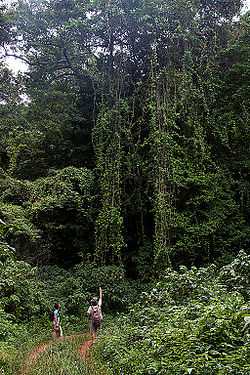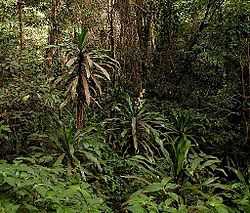Chirinda Forest Botanical Reserve

The 950 ha Chirinda Forest Botanical Reserve is situated on the slopes of Mount Selinda, 30 km south of Chipinge, in the Chipinge Highlands of Manicaland, Zimbabwe,[1][2] and is administered by the Forestry Commission.[3] The reserve is situated at between 900 and 1,200 metres in altitude,[4] and receives some 1,370 mm[5] to 1,466 mm[6] of annual rainfall. 606 ha of its higher levels (above 1,076 metres) is covered by moist evergreen forest,[6][7] specifically Zanzibar-Inhambane transitional rain forest,[8] of which it represents the southernmost occurrence. The headwaters of three streams, namely the Zona, Chinyika and Musangazi, drain the two broad highlands which it encloses.[6] The boundaries of the reserve are not strictly enforced, so that cattle grazing and plant harvesting are ongoing.[4] The reserve is surrounded by communal settlements, commercial timber plantations (eucalypts and pines) and small-scale commercial farming units.[6] The naturalist Charles Swynnerton was appointed manager of the nearby Gungunyana Farm in 1900, and a number of plant, bird and insect names commemorate his collecting activities of the next two decades.[9] Chirinda means "lookout" or "vantage point" in the chiNdau language, or perhaps "place of refuge".[10]
Ecology
The medium altitude forest is likely the southernmost patch of subtropical rainforest in Africa. Phytogeographically it is classed as Afromontane forest, but with lowland and Guineo-Congolian elements. It is situated on two hill tops on dolerite-derived soils, and Müller (1991) proposed that these soil types determine its extent.[6][7] Goldsmith (1876) however suggested that it is only a relic of a once much larger forest which has been reduced by gradual climatic changes in a few hundred years.[6]
Year-round moisture, in the form of either rain, mist or dew, provides for a substantial and intact moist leaf litter layer, on which its ecological processes depend. Decomposition is fungal, and not by termites or similar insects as would be the case in drier woodlands of the region.[7] Several tree species bear fleshy fruit, resulting in a good representation of mammal and bird frugivores,[7] which impact both negatively and positively on seed dispersal.[6] Much of the fauna shows affinities to forests elsewhere, particularly those at lower altitudes along the East Africa coastal plains.[7]
Protection
Protection from fires is expected to facilitate the regeneration and expansion of the forest.[6] During his time of residence, Swynnerton noted that recurring fires had been gradually reducing outlying forest patches. Destruction of portions of the Chipete and Chipungambira satellite forest patches occurred during the 1860s.[11] It may have been aided by elephants which opened up forest, but more likely resulted from indigenous people who regularly cleared land by fire in spring time.[11] Fire-resistant Mobola plum and Mahobohobo trees are pioneer species in such areas.[11]
Maupare (1993) however noted that the forest boundary was stable and that former logging operations in the northern section had no lasting effect on the plant diversity.[11] This extraction of Red mahogany, Peawood and Tannodia during the 1940s also had little effect on its extent.[7]
Flora and fauna

The area is home to a high diversity of plants,[12] fungi, birds, butterflies, insects and reptiles.
Flora
Rare tree species which seldom occur elsewhere in Zimbabwe include the Fluted milkwood (dominant canopy species), Chirinda fig, Undershrub big-leaf, Chirinda stinkwood, Yellow bitterberry and Forest strychnos.[5] The type of the latter species was obtained in the forest by Swynnerton.[13]
The dominant canopy species, besides Fluted milkwood, are Forest mahogany and Peawood.[14] The sub-canopy is occupied by Tannodia, Forest strychnos and Forest ironplum.[6] The Big Tree grows in the southern part of the reserve in the "Valley of the Giants". It is the largest Red mahogany tree in southern Africa and the tallest native tree in Zimbabwe. The 600 to 1,000-year-old (some estimate 2,000-year-old)[15] leviathan has a trunk diameter of about 6 metres. Other forest tree species include colossal specimens of strangling figs, Brown mahogany, White stinkwood, Forest climbing acacia, Ironwood, Giant diospyros, Apricot vine, Forest peach, Forest rothmannia, Strombosia and Forest toad-tree. The forest edge is characterized by Smooth-barked flat-crown, Forest num-num, Forest sword-leaf, Horsewood, Forest croton, Climbing turkey-berry, Manica bride's bush, Green flower tree, Small-fruited teclea, Elbow-leaf.[6] Mitzeerie, Eastern blue-bush, Magic guarri, Orange-milk tree, Lavender tree, Mobola plum, Wild currant and Climbing orange are common species of the surrounding savanna.[6]
Thousands of specimens of the yucca-like Dracaena fragrans populate the forest floor, and numerous ferns, creepers, vines, epiphytes and orchids (including Calanthe sylvatica) are to be found. Montbretia and flame lilies are also present, while guava, lantana[6] and ginger are exotic invasive species.
Fauna
Samango monkeys are regularly seen, and Leopard on the odd occasion. The local race of the Red bush squirrel may be endemic.[7]
Crowned eagles, besides some localized bird species like Chirinda apalis, Swynnerton's robin, Stripe-cheeked greenbul and White-tailed crested-flycatcher occur here. Also present are Trumpeter hornbills, Livingstone's turaco, African pygmy kingfishers, Firefinches, Sunbirds, African green pigeons, Owls, Nightjars and Bee-eaters.
The reptile population includes pythons, cobras, vipers, mambas, adders, chameleons, geckos, skinks and lizards. Marshall's leaf chameleon, an endemic of the Eastern Highlands, is found within the forest and along its margins. The type species C. swynnertoni of the worm lizard genus Chirindia was described from this locality, while another worm lizard, Zygaspis ferox, is endemic to the forest and its vicinity.[16]
The types of Broadley's forest treefrog, Hewitt's long-nosed frog and the Chirinda toad were obtained in the forest. The Chirinda toad is known from Chirinda and the Moribane Forest north of Dombé in adjacent Mozambique.[3] It is a terrestrial species that lives on leaf-litter, and takes refuge under rotten logs.[3]
The Mount Selinda acraea mimic butterfly is found nowhere else.[7] The type of the Ebony bush brown was obtained from Chirinda forest, and it is also known from the Vumba. It flies all year and has distinct seasonal forms.[17] The Chirinda bush brown is named for the forest, but it is in fact a wide-spread species. Its type was obtained at an unknown location in the Eastern Highlands, and it is distinguished from the previous species by its lighter upperside ground-colour, and the contrasting hair pencils of the male.[17]
Facilities
The well-marked route to the campsite leaves the main road just east of the mission hospital in Mount Selinda. It is located 4 km into the forest, and also has chalets with clean facilities and braai stands.[15]
Site locations
- Big Tree, Valley of the Giants 20°26′29″S 32°42′15″E / 20.44139°S 32.70417°E
- Chipete forest 20°24′40″S 32°42′46″E / 20.41111°S 32.71278°E
- Chirinda forest campsite 20°24′37″S 32°41′57″E / 20.41028°S 32.69917°E
- Gungunyana 20°24′29″S 32°43′09″E / 20.40806°S 32.71917°E
- Swynnerton memorial 20°25′18″S 32°41′56″E / 20.42167°S 32.69889°E
See also
- Allophylus chirindensis
- Anthene chirinda
- Chirinda wild medlar
- Neoceratitis chirinda
- Plectranthus swynnertonii, type locality
- Rhus chirindensis
- Turdus olivaceus swynnertoni, Swynnerton's thrush
- Reptiles and frogs of the Eastern Highlands
References
- ↑ Shaw, Phil; Timberlake, Jonathan (1994). Chirinda Forest: a visitors' guide. Harare: Division of Research & Development, Forestry Commission. ISBN 0797413626.
- ↑ Spriggs, Amy. "Zimbabwe, Mozambique: Montane grasslands and shrublands". worldwildlife.org. Retrieved 24 November 2014.
- ↑ 3.0 3.1 3.2 Poynton, John; Channing, Alan (2004). "Mertensophryne anotis". The IUCN Red List of Threatened Species, Version 2014.3. Retrieved 30 November 2014.
- ↑ 4.0 4.1 "Chirinda Forest". Sites - Important Bird and Biodiversity Areas (IBAs). BirdLife International. Retrieved 24 November 2014.
- ↑ 5.0 5.1 Hyde, M. et al. "Location: Chirinda forest". Flora of Zimbabwe. Retrieved 27 November 2014.
- ↑ 6.0 6.1 6.2 6.3 6.4 6.5 6.6 6.7 6.8 6.9 6.10 6.11 Mapaure, Isaac (November 2012). "Determinants of vegetation composition and diversity of a moist forest-savanna boundary in south-eastern Zimbabwe" (PDF). International Journal of Biodiversity and Conservation 4 (14): 584–591. doi:10.5897/IJBC12.071. Retrieved 28 November 2014.
- ↑ 7.0 7.1 7.2 7.3 7.4 7.5 7.6 7.7 Timberlake, Jonathan (6 November 2002). "The Biodiversity and Ecology of Chirinda Forest" (PDF). BFA SEMINAR SERIES NO. 17. Bulawayo Club. Retrieved 27 November 2014.
- ↑ "Chapter 9: Zanzibar-Inhambane transitional rain forest (Fg)" (PDF). VECEA, Volume 2. Retrieved 24 November 2014.
- ↑ Goodier, R. (2007). "Swynnerton, Charles Francis Massey". Flora of Zimbabwe. Retrieved 27 November 2014.
- ↑ Neville, Marilyn (1961). "Scenic Splendours of the Eastern Districts". OurStory. U.G.H.S Borderer. Retrieved 1 December 2014.
- ↑ 11.0 11.1 11.2 11.3 Spinage, Clive A. (2012). African ecology: benchmarks and historical perspectives (1 ed.). Berlin: Springer. p. 295. ISBN 3642228712.
- ↑ Hyde, M.A. et al. "Plant records: Chirinda Forest". Flora of Zimbabwe. Retrieved 5 December 2014.
- ↑ Leeuwenberg, A. J. M. "Strychnos mellodora S. Moore". Flora Zambesiaca: FZ volume:7 part:1 (1983) Loganiaceae. Kew. Retrieved 27 November 2014.
- ↑ Müller, Tom (2006). "The distribution, classification and conservation of rainforests in eastern Zimbabwe" (PDF). Occasional Publications in Biodiversity No. 19. Biodiversity Foundation for Africa. Retrieved 27 November 2014.
- ↑ 15.0 15.1 Murray, Paul (2013). Zimbabwe (2 ed.). [S.l.]: Bradt Pubns. pp. 337–338. ISBN 1841624608.
- ↑ Branch, Bill (1998). Field guide to snakes and other reptiles of southern Africa (3 ed.). Cape Town: Struik. p. 122. ISBN 9781868720408.
- ↑ 17.0 17.1 Pringle, et al., 1994
Coordinates: 20°25′27″S 32°41′40″E / 20.42417°S 32.69444°E
Further reading
- Armitage FB (1965). Project Document: Chirinda Forest. Forestry Commission (Ref. 784/FBA/EHC), Gungunyana Forest Research Station, Chipinge.
- Goldsmith B (1976). The trees of Chirinda forest. Rhod. Sci. News 10:41-50.
- Hoffmann, Annette. Chirinda Forest Reserve in Simbabwe – südlichster tropischer Regenwald Afrikas, afrikascout.de
- Mapaure I (1997). A floristic classification of the vegetation of a forest-savanna boundary in south-eastern Zimbabwe. Bothalia 27(2):185-195.
- Mujuru L, Kundhlande A (2007). Small-scale vegetation structure and composition of Chirinda Forest, southeast Zimbabwe. Afr. J. Ecol. 45:624-632.
- Müller T (1991). Rainforests of Zimbabwe. Unpublished report, National Herbarium and Botanic Garden, Department of Research Specialist Services, Harare.
- Swynnerton, CFM (1918). Some factors in the replacement of the ancient East African forest by wooded pasture land. S. Afr. J. Sci. 14, 493-518
- Timberlake J (1991). Tour report - Chirinda, Haroni and Rusitu Forests. Internal report, Forest Research Centre, Harare.
- Timberlake J (1992a). Findings from a comparison of aerial photographs of Chirinda forest from 1959 to 1987. Unpublished Report, Forest Research Centre, Harare.
- Timberlake J (1992b). Chirinda Forest: Conservation of a Rainforest in Zimbabwe. Paper presented at the SAREC International Symposium on Ecology and Conservation of Indigenous Forests, July 1992, Victoria Falls, Zimbabwe.
- Timberlake J (1994b). Changes in the extent of moist forest patches in the Eastern Highlands: Case studies based on aerial photographs. Forest Research Paper No. 7. Forestry Commission, Harare.
External links
![]() Media related to Chirinda Forest Botanical Reserve at Wikimedia Commons
Media related to Chirinda Forest Botanical Reserve at Wikimedia Commons
- Photos of Peawood in the Eastern Highlands, Iziko Museums